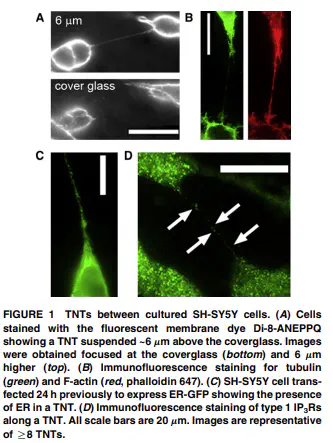
Abstract
A new mechanism of cell-cell communication was recently proposed after the discovery of tunneling nanotubes (TNTs) between cells. TNTs are membrane protrusions with lengths of tens of microns and diameters of a few hundred nanometers that permit the exchange of membrane and cytoplasmic constituents between neighboring cells. TNTs have been reported to mediate intercellular Ca(2+) signaling; however, our simulations indicate that passive diffusion of Ca(2+) ions alone would be inadequate for efficient transmission between cells. Instead, we observed spontaneous and inositol trisphosphate (IP(3))-evoked Ca(2+) signals within TNTs between cultured mammalian cells, which sometimes remained localized and in other instances propagated as saltatory waves to evoke Ca(2+) signals in a connected cell. Consistent with this, immunostaining showed the presence of both endoplasmic reticulum and IP(3) receptors along the TNT. We propose that IP(3) receptors may actively propagate intercellular Ca(2+) signals along TNTs via Ca(2+)-induced Ca(2+) release, acting as amplification sites to overcome the limitations of passive diffusion in a chemical analog of electrical transmission of action potentials